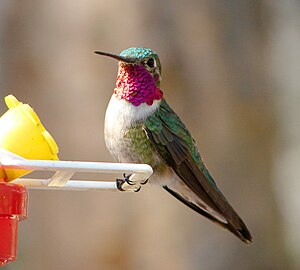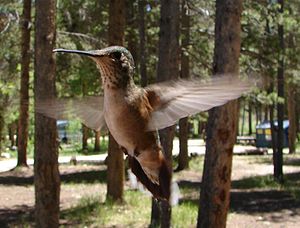Difference between revisions of "Field Guide/Birds/Archilochus colubris"
m (- Category of AYHAB) |
|||
| (70 intermediate revisions by 12 users not shown) | |||
| Line 1: | Line 1: | ||
| − | + | {{Bird id | |
| − | + | | name = Ruby-throated Hummingbird | |
| − | + | | latin_name = Archilochus colubris | |
| − | + | | level = 4 | |
| − | + | | image_1 = Rubythroathummer65.jpg | |
| − | + | | caption_1 = Ruby-throated Hummingbird | |
| − | + | | image_2 = Male Ruby-Throated Hummingbird 1.jpg | |
| − | + | | caption_2 = Male Ruby-Throated Hummingbird | |
| − | + | | image_3 = Female Ruby-Throated Hummingbird in Flight.jpg | |
| − | + | | caption_3 = Female Ruby-Throated Hummingbird | |
| − | + | | range_map = Rubinkehlkolibri (a. colubris) world.png | |
| − | + | | call = Archilochus colubris.ogg | |
| − | + | | description = The '''Ruby-throated Hummingbird''' (''Archilochus colubris''), is a small hummingbird. It is the most common species of hummingbird that breeds in the eastern half of North America. | |
| − | The | + | The Ruby-Throated Hummingbird is 7-9 cm long with an 8-11 cm wingspan, and weighs 2-6 g. Adults are metallic green above and greyish white below, with near-black wings. Their bill is long, straight and very slender. The adult male has an iridescent ruby red throat patch which may appear black in some lighting, and a dark forked tail. The female has a dark rounded tail with white tips and generally no throat patch, though she may sometimes have a light or whitish throat patch. The male is smaller than the female, and has a slightly shorter beak. A moult of feathers occurs once per year, and begins during the autumn migration. |
| − | + | The breeding habitat is throughout most of eastern North America and the Canadian prairies, in deciduous and pine forests and forest edges, orchards, and gardens. The female builds a nest in a protected location in a shrub or tree. | |
| − | + | The Ruby-throated Hummingbird is migratory, spending most of the winter in Mexico or Central America. | |
| − | + | Ruby-throated hummingbirds are solitary. Adults of this species typically only come into contact for the purpose of mating, and both males and females of any age aggressively defend feeding locations within his or her territory. The aggressiveness becomes most pronounced in late summer to early fall as they fatten up for migration. They feed frequently while active during the day and when temperatures drop, particularly on cold nights, they may conserve energy by entering hypothermic torpor. | |
| − | + | The birds feed on nectar from flowers and flowering trees using a long extendable tongue or catch insects on the wing. Due to their small size, they are vulnerable to insect-eating birds and animals. | |
| − | + | Females lay two white eggs averaging {{units|12.9 by 8.5 mm|0.5 by 0.3 in}}. | |
| − | Due to their small size, they are vulnerable to insect-eating birds and animals. | + | }} |
| − | |||
| − | |||
| − | |||
| − | |||
| − | |||
| − | |||
| − | |||
| − | |||
| − | |||
Latest revision as of 00:24, 19 July 2022
| Archilochus colubris (Ruby-throated Hummingbird) | |
|---|---|
| Description | |
| The Ruby-throated Hummingbird (Archilochus colubris), is a small hummingbird. It is the most common species of hummingbird that breeds in the eastern half of North America.
The Ruby-Throated Hummingbird is 7-9 cm long with an 8-11 cm wingspan, and weighs 2-6 g. Adults are metallic green above and greyish white below, with near-black wings. Their bill is long, straight and very slender. The adult male has an iridescent ruby red throat patch which may appear black in some lighting, and a dark forked tail. The female has a dark rounded tail with white tips and generally no throat patch, though she may sometimes have a light or whitish throat patch. The male is smaller than the female, and has a slightly shorter beak. A moult of feathers occurs once per year, and begins during the autumn migration. The breeding habitat is throughout most of eastern North America and the Canadian prairies, in deciduous and pine forests and forest edges, orchards, and gardens. The female builds a nest in a protected location in a shrub or tree. The Ruby-throated Hummingbird is migratory, spending most of the winter in Mexico or Central America. Ruby-throated hummingbirds are solitary. Adults of this species typically only come into contact for the purpose of mating, and both males and females of any age aggressively defend feeding locations within his or her territory. The aggressiveness becomes most pronounced in late summer to early fall as they fatten up for migration. They feed frequently while active during the day and when temperatures drop, particularly on cold nights, they may conserve energy by entering hypothermic torpor. The birds feed on nectar from flowers and flowering trees using a long extendable tongue or catch insects on the wing. Due to their small size, they are vulnerable to insect-eating birds and animals.
Females lay two white eggs averaging 12.9 by 8.5 mm | |




